The Champions League returns and it’s two of Europe’s super clubs facing off. Real Madrid is set to host Chelsea at the Estadio Alfredo Di Stefano for the first leg of the Champions League semifinal.
Both teams enter the tie in good form and reasonably rested for the midweek tilt. Resting key players cost Real Madrid in their bid to defend their La Liga title, but it sets the stage for a match Zinedine Zidane described as, “our most difficult of the entire season.”
In London, Chelsea was forced to play a near preferred XI in a six-pointer against West Ham. The convincing 1-0 victory put the Blues three points ahead of their city rivals in the bid for 4th place.
As each team prepares for Tuesday night’s semifinal first leg, this tactical analysis will gaze into the future, predicting the starting XIs, tactics and result.
Lineups
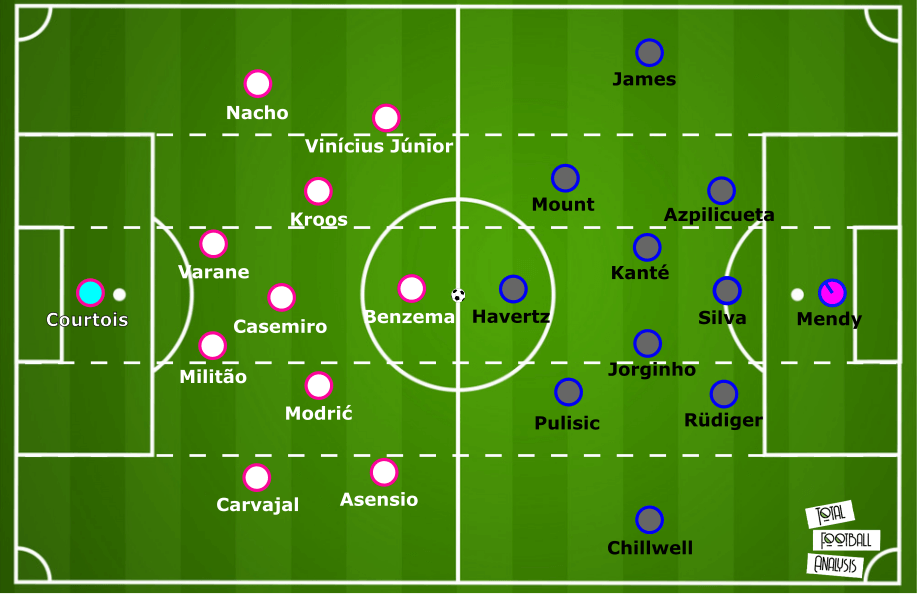
Zidane will likely go with a 4-3-3 in this match with former Chelsea star Thibaut Courtois in goal. His backline is gradually returning to health and will feature Dani Carvajal on the right side of defence. Éder Militão, Raphaël Varane, Nacho Fernández will complete the remainder of the backline with the Spaniard operating as the left-back. Ferland Mendy should make the bench as he returns from injury, but he’s likely to start there. In midfield, Casemiro will start at the #6, Luka Modrić as the right centre midfielder and Toni Kroos playing a deeper role as the left-centre midfielder. From right to left, look for the forward line to feature Marco Asensio, Karim Benzema and Vinícius Júnior. Madridistas and Blue fans are likely to see an old friend in the match with Eden Hazard likely to make the bench.
Thomas Tuchel will likely stick with a 3-4-2-1 and start Édouard Mendy in goal. César Azpilicueta, Thiago Silva and Antonio Rüdiger are likely to form the back three. In midfield, look for Reece James, N’Golo Kanté, Jorginho and Ben Chilwell from right to left. Underneath the striker, Mason Mount and Christian Pulisic are the likely duo while Kai Havertz beats out Timo Werner for the start up top.
Defences will shine
Since Tuchel arrived in London, Chelsea has averaged 1.76 xG vs 0.58 xGA per match. They have 10 clean sheets in 14 matches while conceding eight goals. Keep in mind five of those came against West Bromwich. Take away that match and the tally’s down to three goals against over 13 matches and the xGA P90 drops to 0.51.
On the other side of the pitch, Real Madrid has navigated an absurd number of injuries along the backline and is now seeing Militão and Nacho routinely put in high performances. The two players have found their form and are joined at the back by the now healthy Varane. Nacho will play on the left-hand side which will allow him to use his speed and stamina to get up and down the left-wing, but it also gives Zidane the option of using the Spaniard as more of a stay-at-home defender to protect against Chelsea’s counterattacks.
Both teams have performed extraordinarily well defensively since the turn of the calendar to 2021, and at the heart of their performances are the rest defences implemented by the two coaches. For Tuchel, his 3-4-2-1 allows him to take away the centre of the pitch with his three centrebacks and two holding mids. That 3-2 at the back, much as we saw with Manchester City last season, allows Chelsea to funnel opponents into the wings, delay their attacks and allow for the two wingbacks to recover.
Our image below shows their rest defence among the back five against Liverpool. The three centrebacks range from half space to half space while the two holding mids protect the space in front of them.
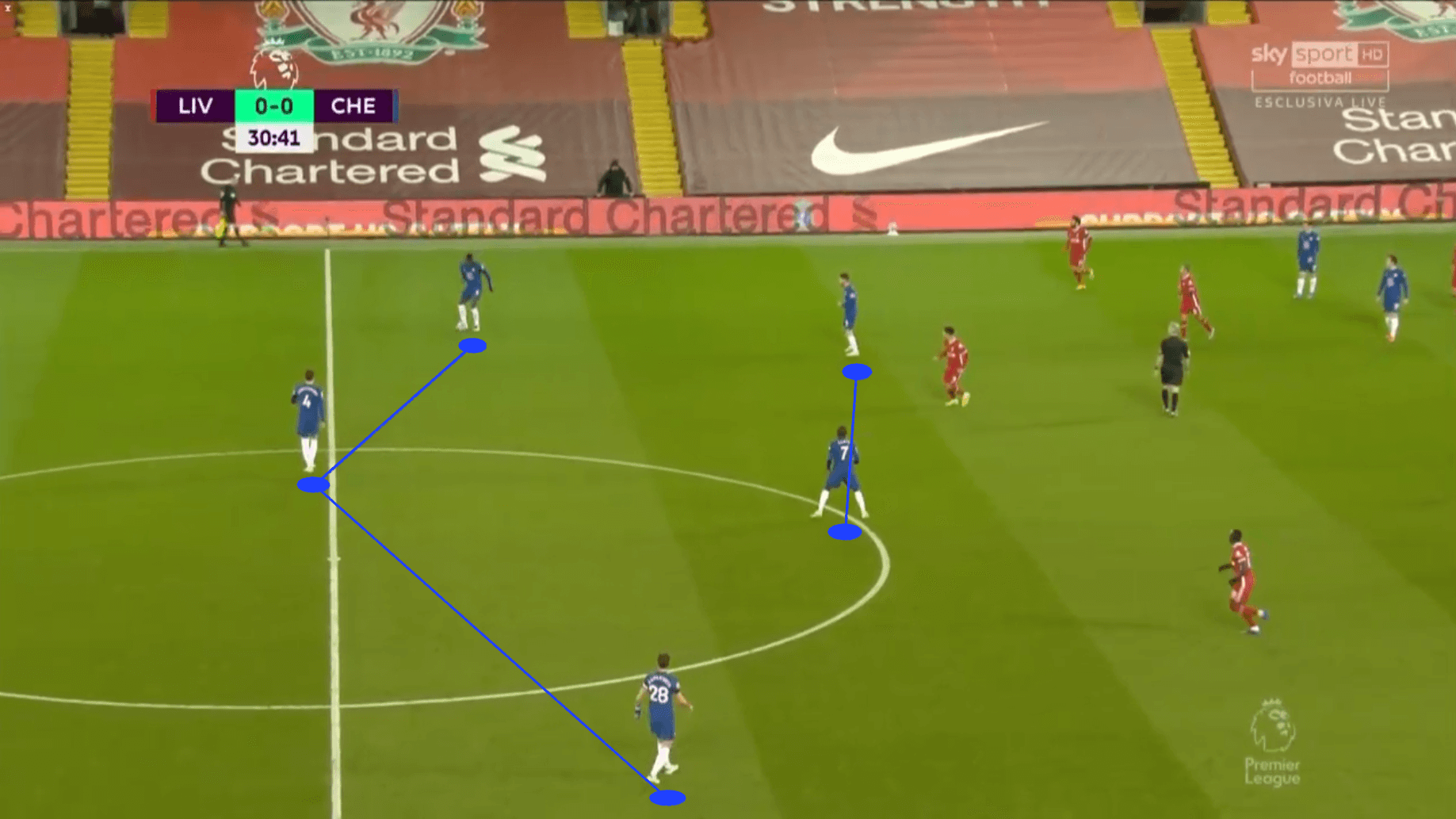
Higher up the pitch, we see Chelsea once again in possession and how the rest defence sets him up to quickly counterpress, protect the middle of the pitch and give the wingbacks a straightforward recovery. Within their attacking tactics, the Blues get their width in attack from the two wingbacks while the remaining eight field players overload the central channel and half spaces.
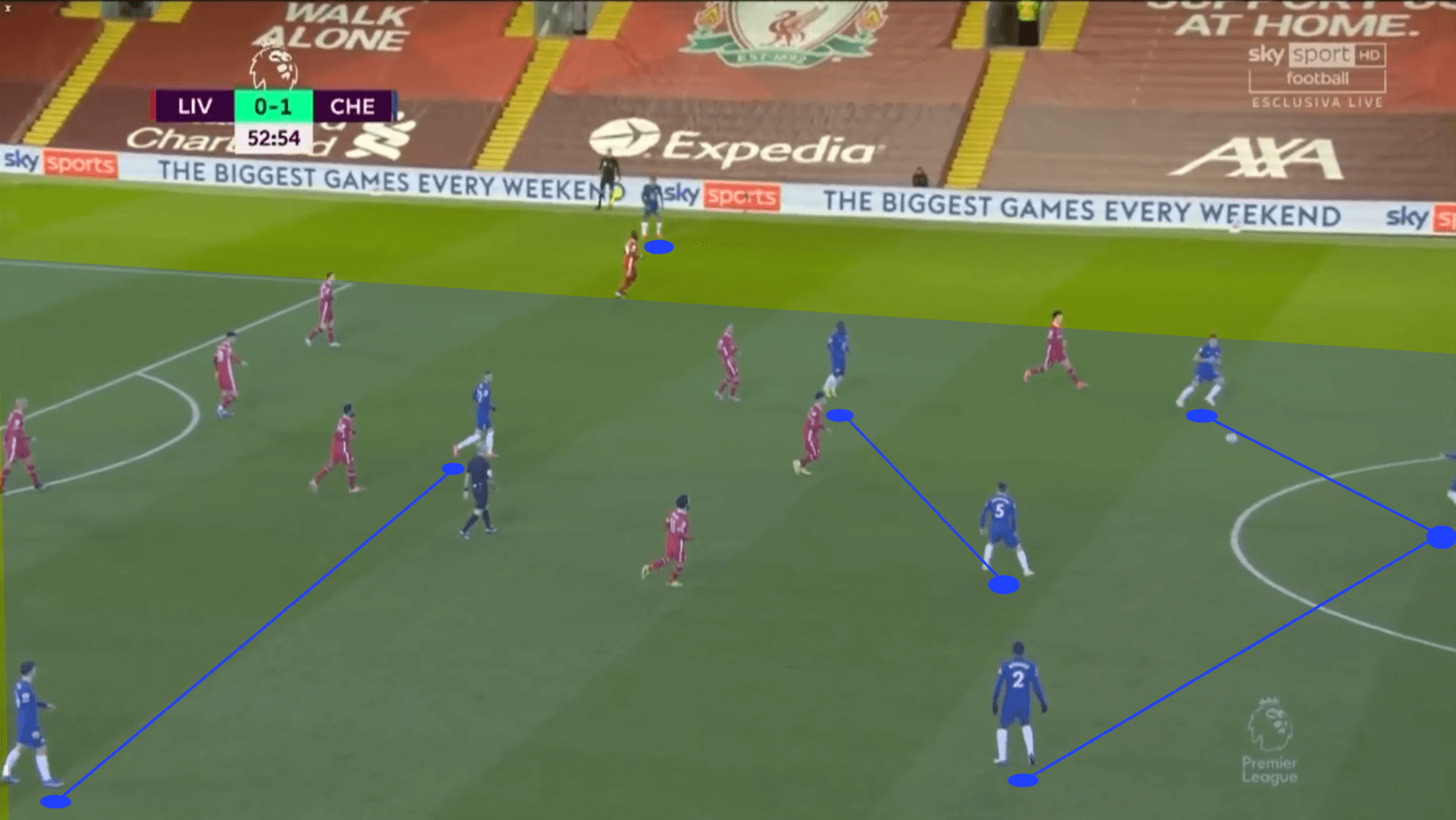
Chelsea has been the possession dominant team in most of Tuchel’s games at the helm, which highlights the importance of their rest defence. Though they’re unlikely to out-possess Real Madrid in the Spanish capital, we should still see Chelsea garner approximately 45% of the ball. In their open possessions, a sound rest defence will be critical to stopping Real Madrid’s transitional attacking, especially if Vinícius Júnior is playing at his best.
Looking at Chelsea’s defence when they’re out of possession, the two defensive midfielders will be the key. Real Madrid is accustomed to facing middle and low blocks in La Liga, and will move the ball methodically to shift Chelsea’s lines vertically and horizontally. For Chelsea, the priority is in Kanté and Jorginho navigating the space between the centrebacks and attacking mids.
Looking at Chelsea’s match against Manchester City, a club that does well to manipulate the opposition’s defensive shape to create gaps in the central channel and half spaces, we saw Manchester City attack in the wings, occasionally playing negative passes, to move the Chelsea holding mids higher up the pitch to then target the space between the lines.
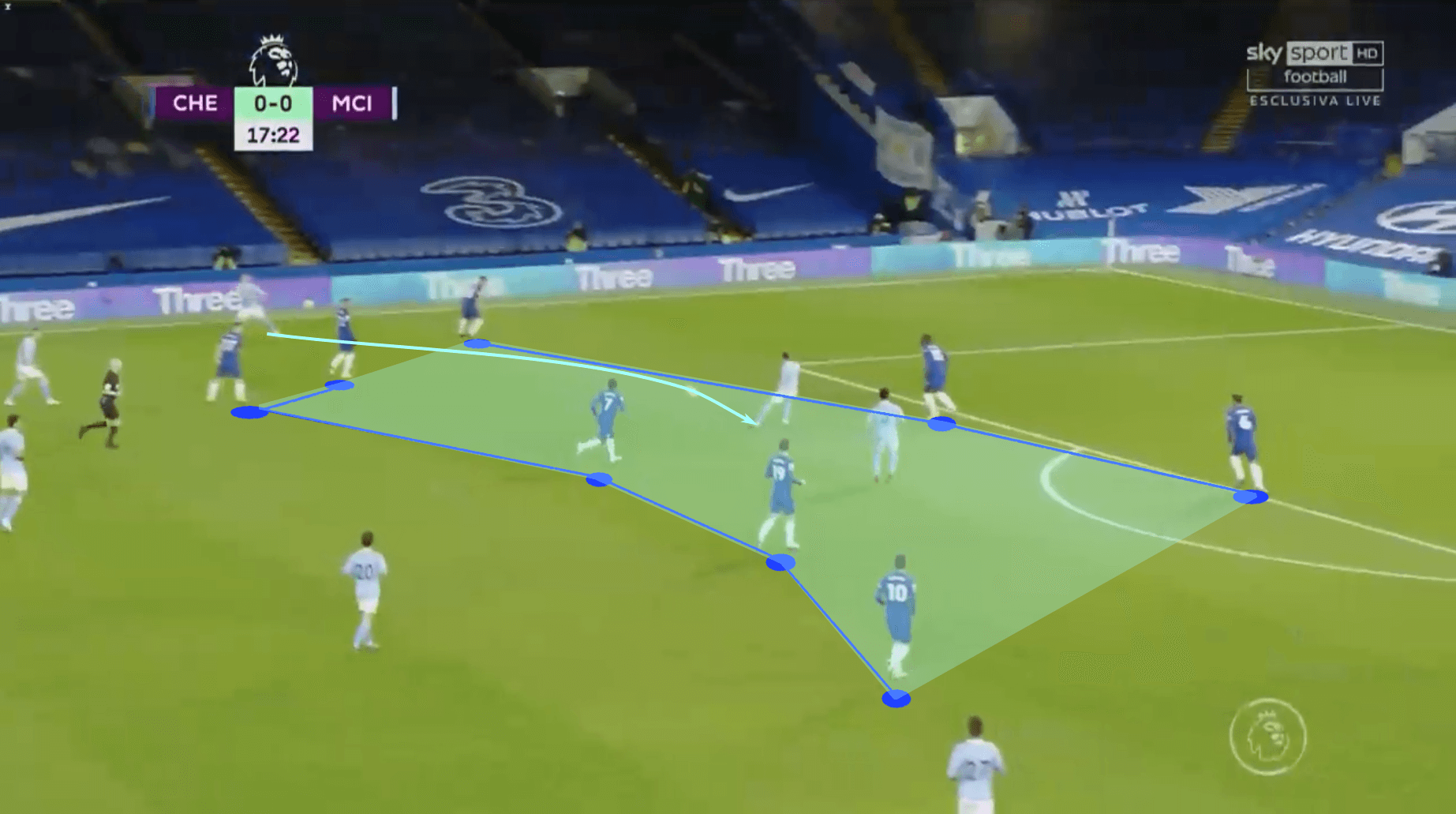
City created a 2v1 against Rüdiger, receiving the ball in front of him which enabled them to run at the isolated centreback.
From Real Madrid’s perspective, they will also prioritize a strong rest defence. Depending on the threat Chelsea offers moving forward, Nacho could play a more conservative role, starting deeper and inverting to deny deep half space outlets to Mount.
That said, there might not be a need for such precautions. If you’ve watched Real Madrid with any regularity, you know that Zidane orients his centrebacks, Casemiro, and Kroos in a central oriented square in the team’s rest defence. We’ll talk about the attacking benefits of Kroos’s positioning in the left half space shortly, but the defensive benefit is that the German will sit in the space that Mount typically occupies. That will allow him to contest outlet passes played into Mount. Casemiro will do the same in the right half space, denying passes into the feet of Pulisic.
In terms of their pressing scheme, look for Real Madrid to engage in the counterpress to 1) deny progression and 2) recover the ball. If Chelsea beats the counterpress, look for Real Madrid to settle into a 4-1-4-1 middle block with Casemiro patrolling the spaces between the lines. Also look for Vinícius Júnior and Marco Asensio to drop back with James and Chilwell.
Transitions will sway the tie
Though both teams have an abundance of attacking talent at their disposal, expect their attacking success to come through transitions. In part, that’s due to the defensive strength and structure of the two teams.
As our analysis of rest defence in the prior section shows, even success in transitional attacks will be limited. That’s due to the disciplined in-possession structure of the two teams. Chances will be few and far between, but as well as the two clubs are performing defensively, you do get the sense that the goals, or at least opportunities to goal, will come from attacking transitions or set pieces.
Starting with Chelsea’s transitional attacking, it’s the movement from defending in the low block to connecting with the two attacking mids that’s critical. Below, we have an example of Chelsea sitting in their low block with excellent coverage of the central channel and half spaces. Any ball played into that area is likely there’s. And in this case, it is.
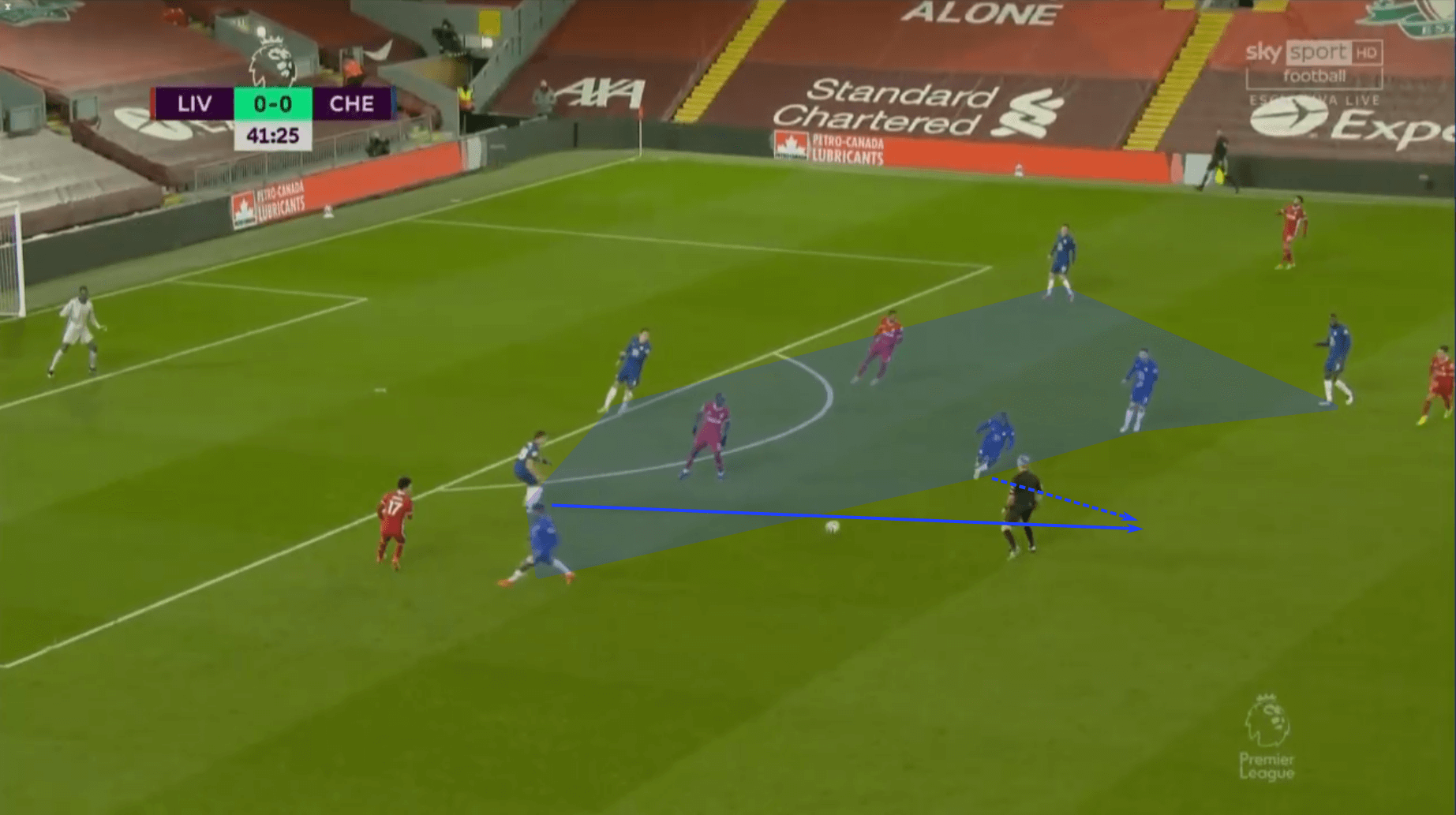
Azpilicueta heads the first ball, then Kanté wins the second and plays an excellent ball into the path of Mount. He’s found a gap behind Trent Alexander-Arnold and has attacked it at pace.
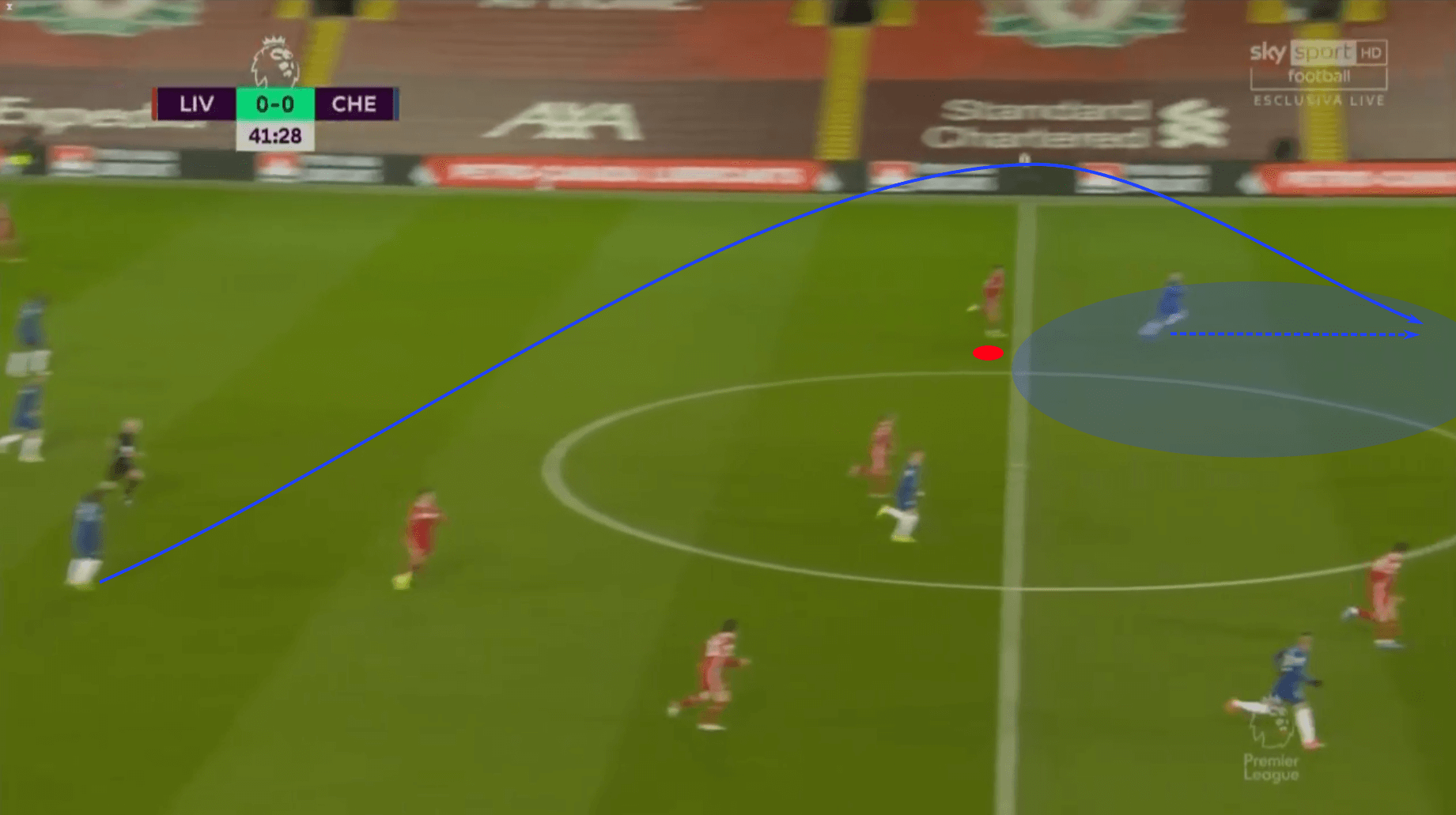
Once Chelsea enters or nearest the box from the counterattack, it’s the coordinated movements of the three highest players, driving to Liverpool backline close to goal, that are key. They allow Mount to cut in on his right foot and release his shot for the goal. Not only has Chelsea set him up from a decent spot in the box, but they’ve also screened Alisson, making the save all the more difficult.
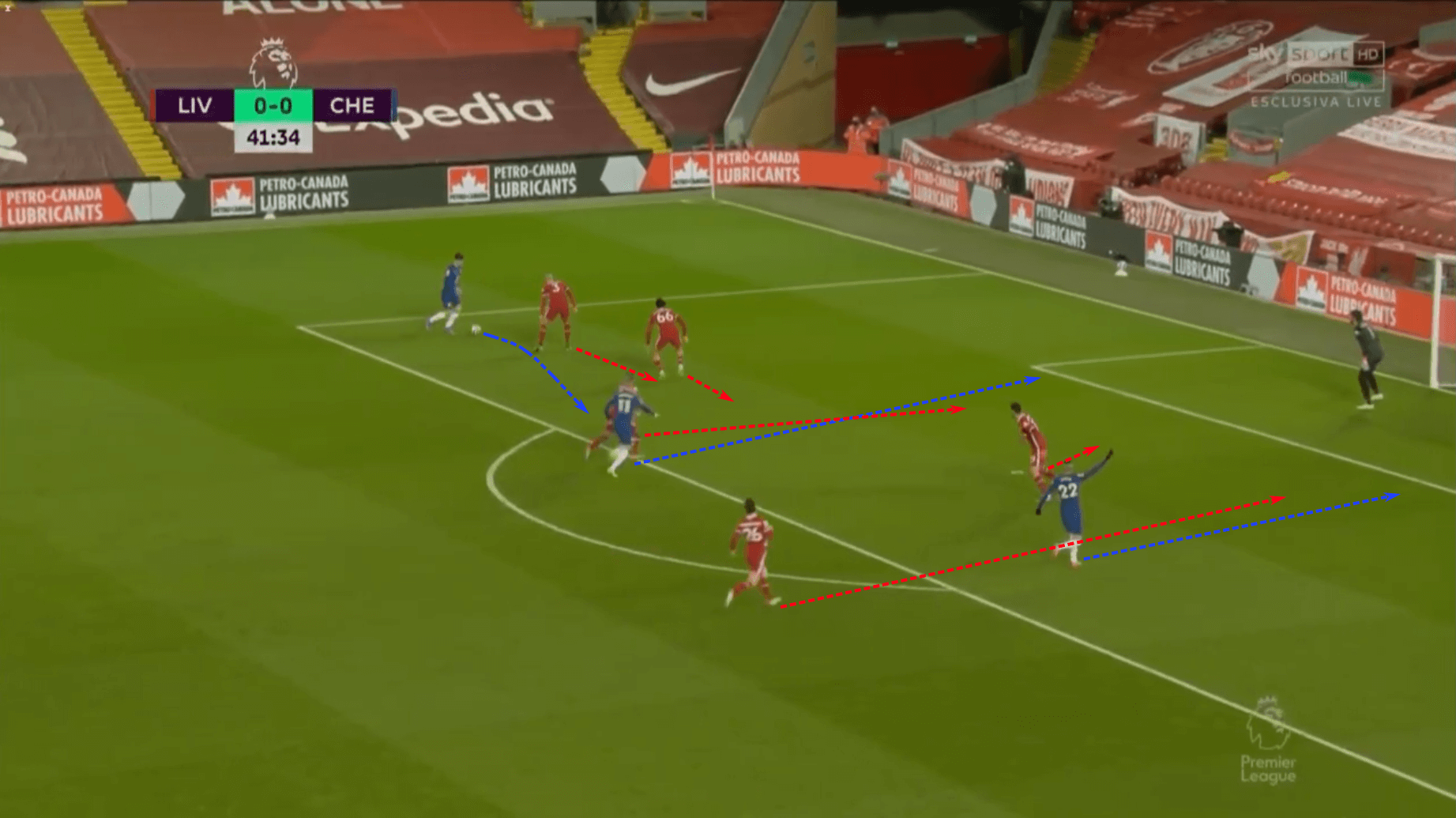
Turning now to Real Madrid, Vinícius Júnior is the key man in transitional attacks. Whether against Liverpool’s back four or Barcelona’s back three, Real Madrid consistently found ways to play the speedy Brazilian behind the backline. If he wasn’t running behind the line, he was often isolated against one defender with room to run into. Look for Los Blancos to take a similar approach in this match, testing Rüdiger’s ability to defend Vinícius Júnior in space.
His Clásico match up against Óscar Mingueza offers insight into how Madrid will approach this matchup. When Barcelona lost possession in Real Madrid’s half of the pitch, Real Madrid targeted the space behind Barcelona’s right-centreback, looking to Vinícius Júnior for attacking third progression.
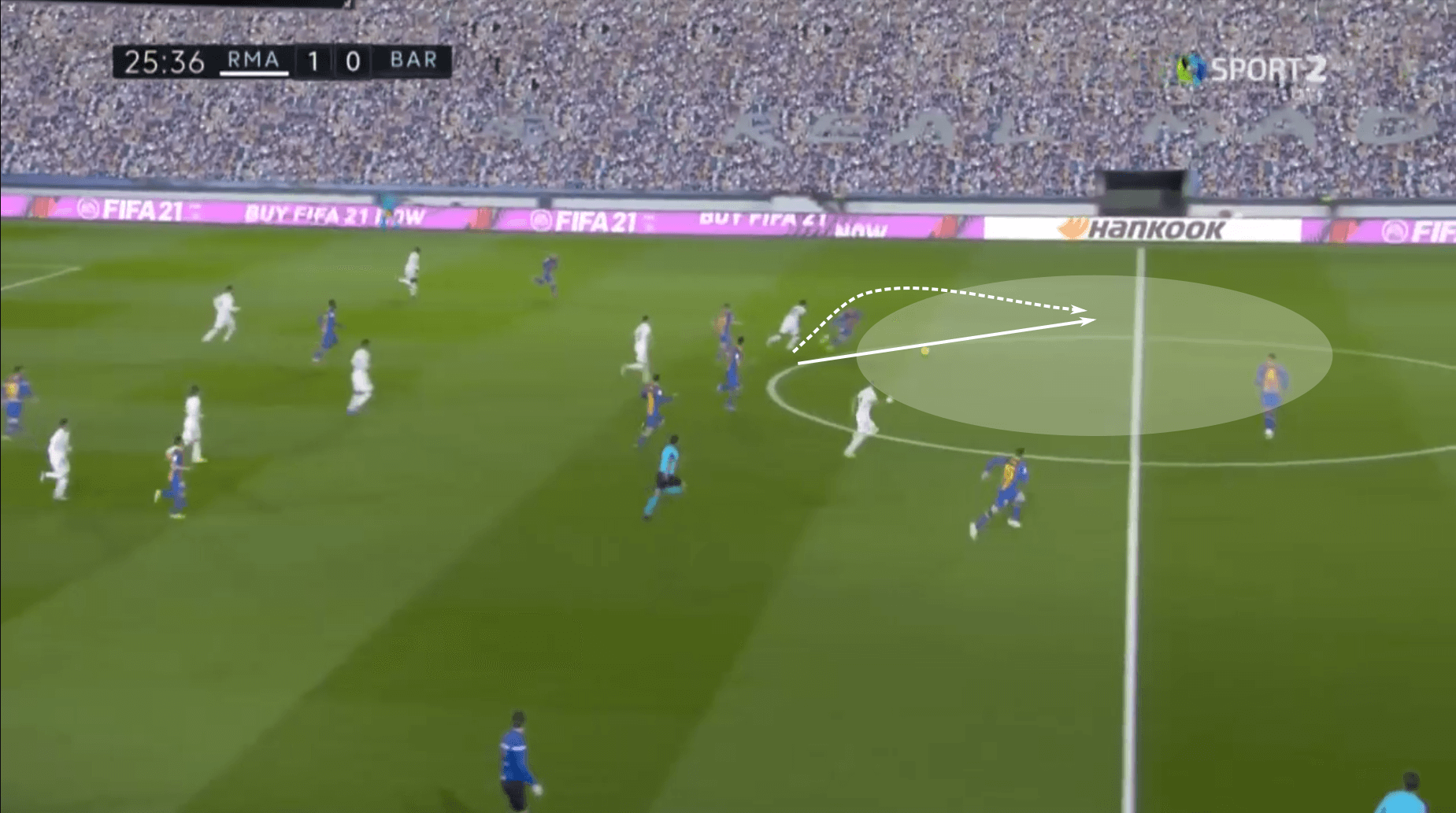
Most of the attacking transitions will target Vinícius Júnior versus Rüdiger on the La Liga team’s left, but don’t be surprised if Real Madrid looks to stretch Chelsea’s back three to play centrally. If the two wingbacks aren’t able to recover in time, Real Madrid will enjoy a 3v3 against Chelsea centrebacks. If the two wide forwards play in the wider reaches of the half spaces, they’ll create running lanes right through the middle of the back three. An example of this sequence comes from Chelsea’s match against Southampton. The Saints engaged the backline in a 3v3 and split the defence with a through ball from midfield. This is where Modrić can do some damage. If he can receive the ball facing forward in front of the two holding mids, that’s a pass he’s comfortable sending.
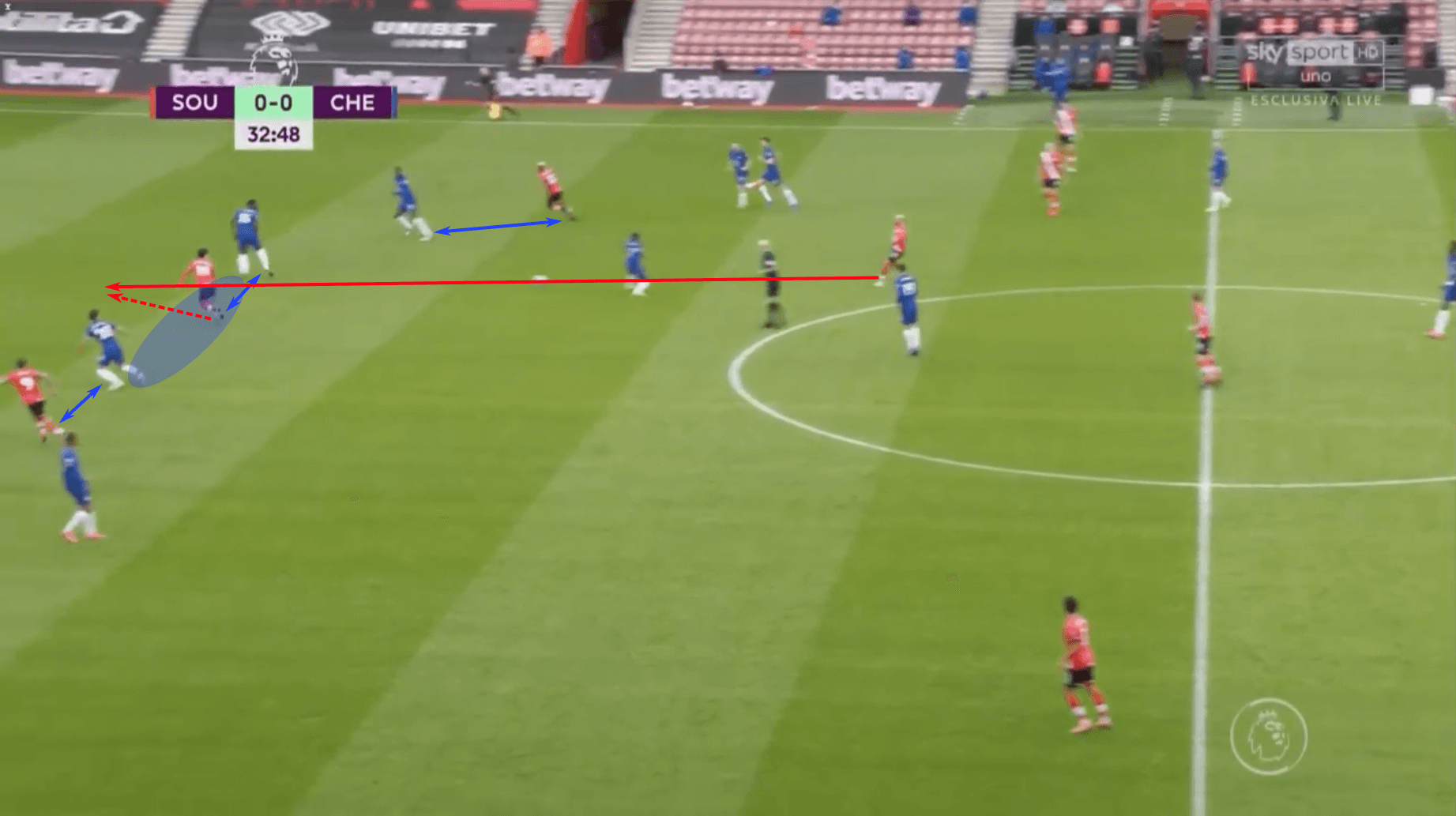
Since Real Madrid should enjoy more of the ball, Chelsea will likely have more opportunities for transitional attacking. However, Real Madrid’s matches against Liverpool and Barcelona offer proof that they only need a few counterattacks to do their damage and claim a result.
Real Madrid’s open possessions vs Chelsea’s low and middle blocks
Since Real Madrid will likely enjoy a 10% margin in possession, the next goal of this analysis is to figure out what they’ll do with it. Studying film on Chelsea, it’s abundantly clear that opponents struggle to break them down once they’ve entered the low block. The wingbacks can join the back three while the two attacking mids support the two defensive mids to give a 5-4-1. Chelsea takes control of the match by defending in numbers close to the ball. You’ll often see one or two players near the middle of the pitch, but the remainder of the team is near the ball to choke out all short and intermediate-range passes. When they’re set up in the low block, they’re extraordinarily clinical.
But Real Madrid has ample experience playing against middle and low block clubs. Look for Zidane’s men to prioritize the point of engagement as they initiate their attack upon the opponent.
What we mean here is that even if Chelsea settles into a low block, don’t expect Real Madrid to butt their heads against a brick wall. Rather than taking the bait and engaging Chelsea’s low block, look for them to play negative to Kroos and the centrebacks to draw Chelsea’s defensive structure higher up the pitch. They’ll also frequently switch the point of attack. The sequence of passes to probe the width of the pitch and the y-axis will aim to create spaces in Chelsea’s structure.
Manchester City gives a nice example of passing around and through Chelsea’s defensive overloads near the ball. In the example below, Chelsea’s pitch coverage offers them positional dominance near the ball. While still overloading near the ball to protect possession and enable an efficient counterpress, Manchester City also fit their attacking structure around the Chelsea press.
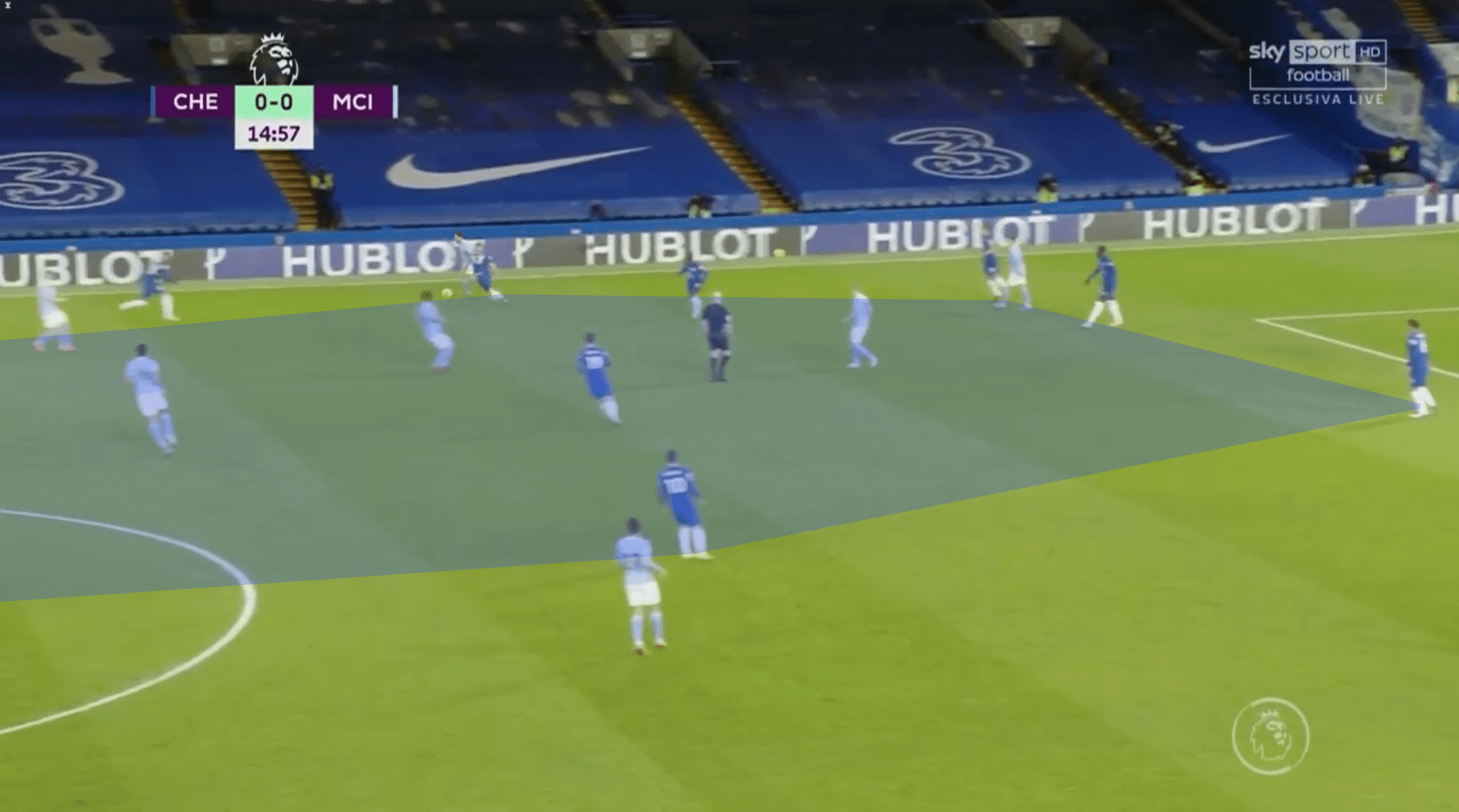
After a quick and effective switch of play, City created the space they wanted to attack, finding the gap between the centrebacks.
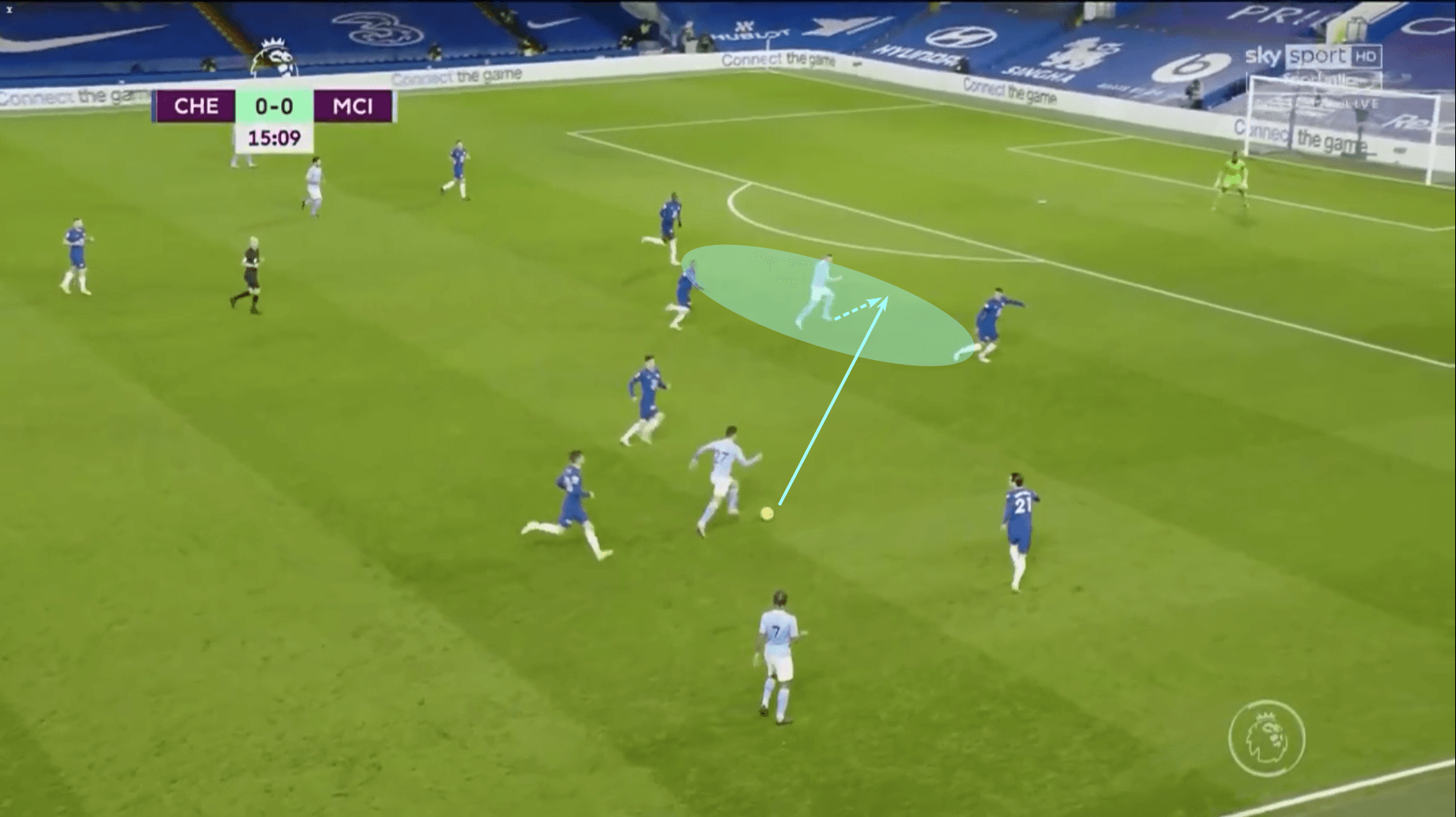
Liverpool had a similar approach to Real Madrid’s open attacks. To limit success in short and intermediate-range passes, Liverpool became unbalanced near the ball, allowing Real Madrid to play out of the press and switch the point of attack. The image below gives a sense of pitch coverage. While Liverpool aggressively hunted tackles and interceptions near the ball, Real Madrid looked to take advantage of the far side of the pitch.
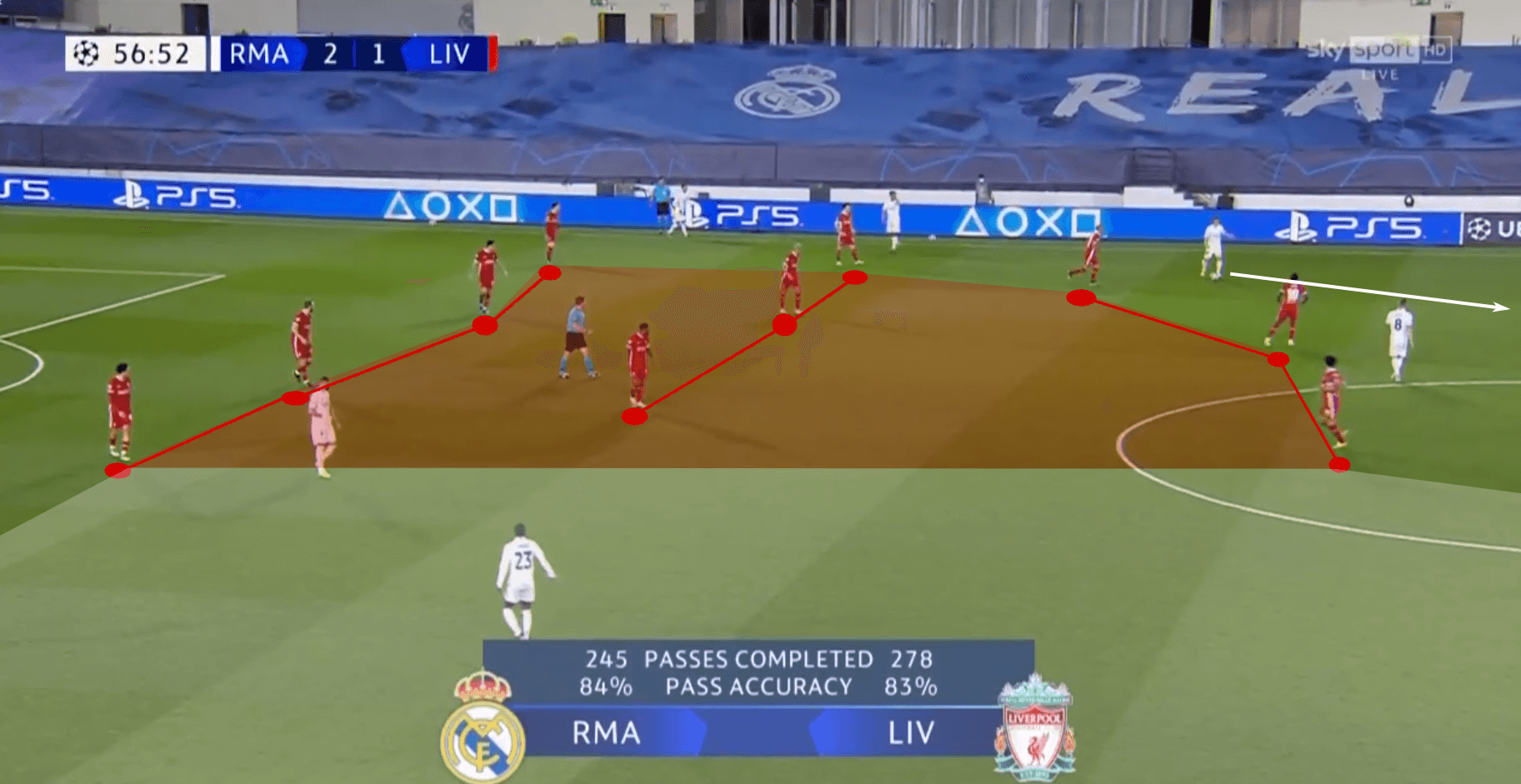
Once Real Madrid switched the point of attack, they were able to play into Vinícius Júnior on the left, forcing Liverpool to quickly adapt their defensive shape to the new threat.
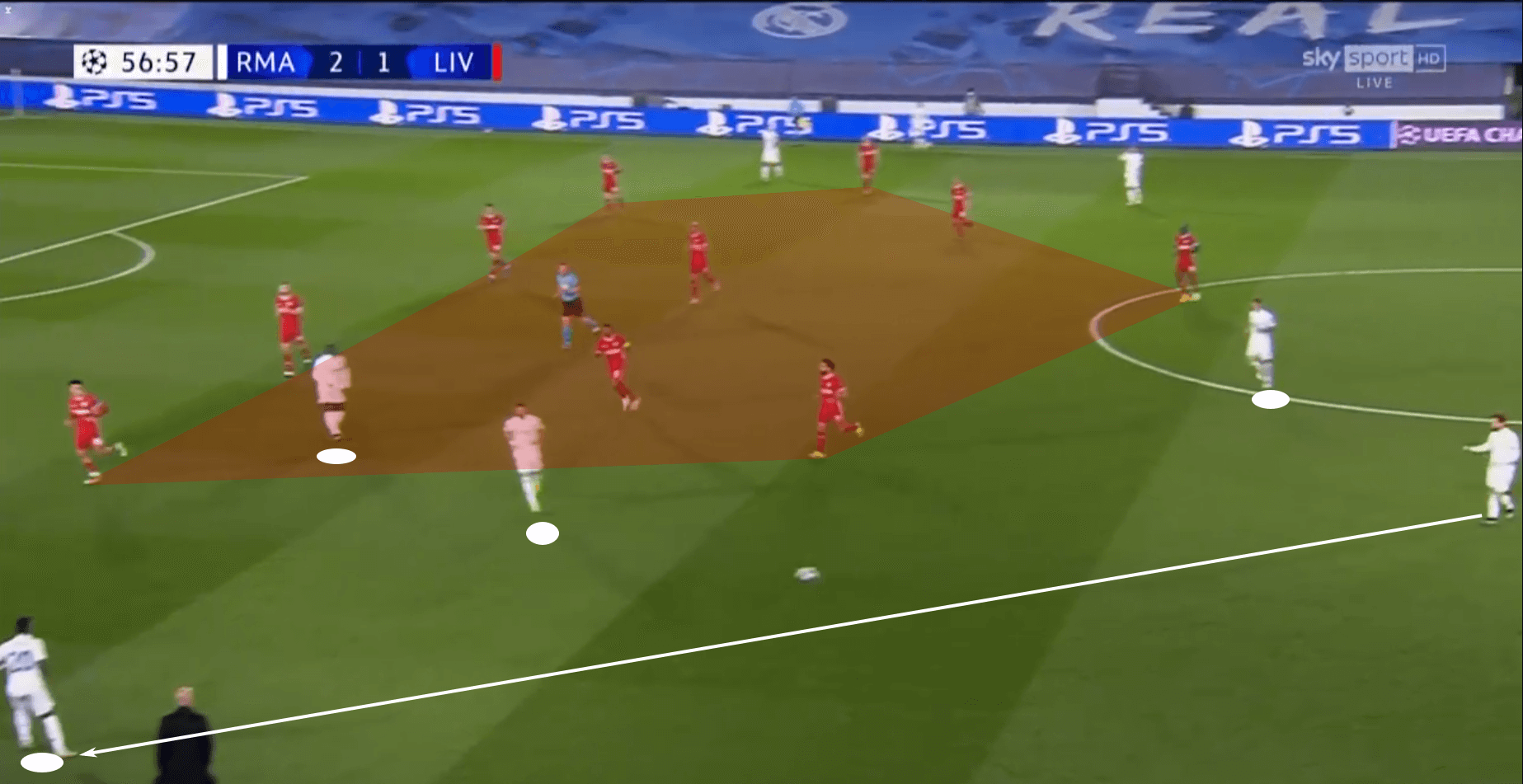
When Liverpool completed the move to Real Madrid’s left, Vinícius set the ball to Kroos, who then played the long switch to Lucas Vázquez. The right-back won his 1v1 duel, forcing Liverpool to quickly slide back to Real Madrid’s right. With the side-to-side movements, the defence lost track of Benzema, who was targeted on the subsequent cross.
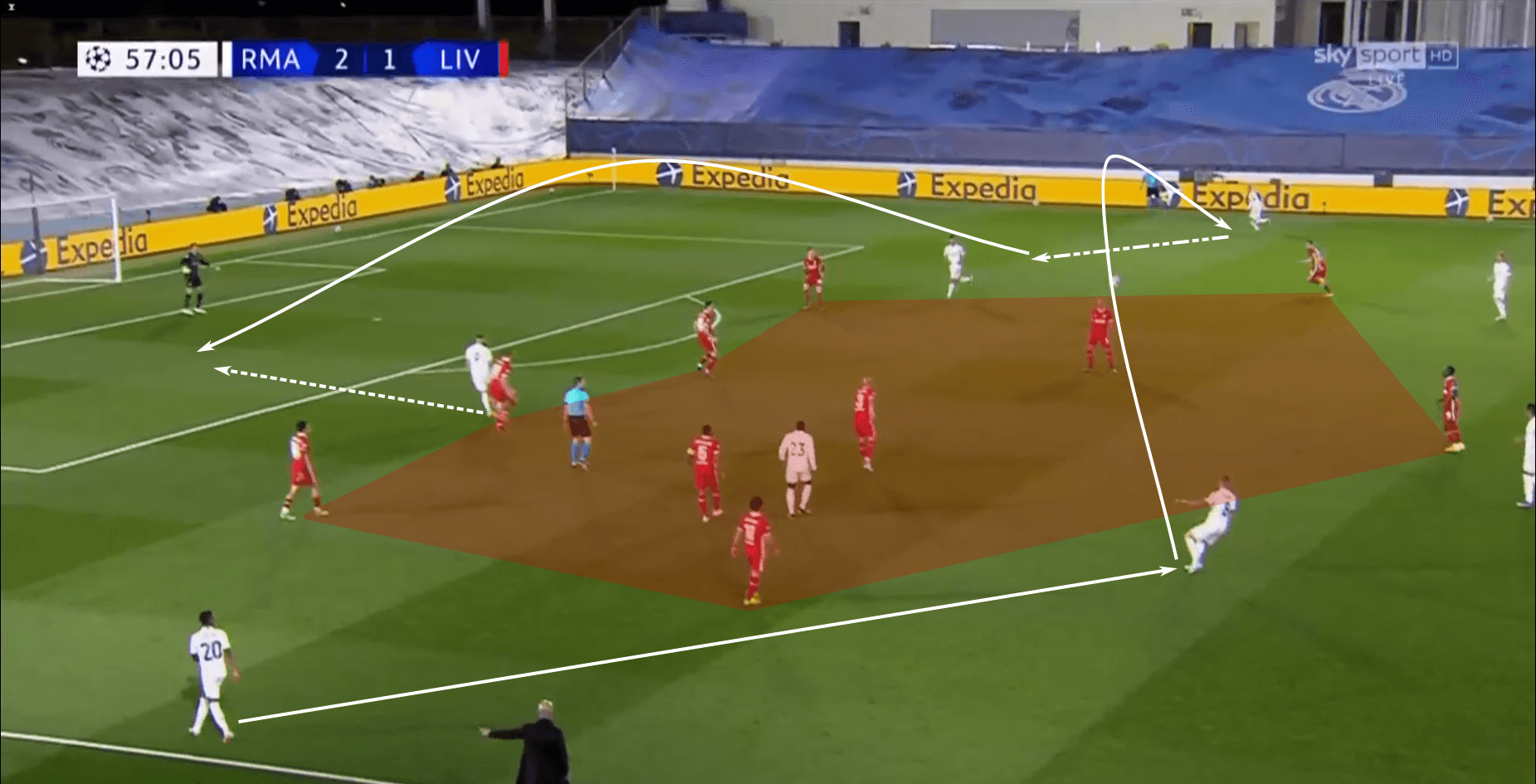
Though attacking transitions will offer the greatest chance of success, Real Madrid will look to test Chelsea’s defensive shape, either by moving them higher up the pitch into the middle block before playing forward or by using probing passes along the x and y axes to disorient the defence and spring players behind the backline.
Conclusion
This will be a tight match with few opportunities for either team. As well as the two teams are performing defensively, there’s just a sense that we’ll see a low scoring tie, much like Chelsea’s matchup against Porto.
Look for Real Madrid to show more attacking initiative in this leg in an attempt to set themselves up for a strong defensive display in England. Either way, both teams will take a more pragmatic approach to this first leg with the understanding that a single goal in either direction will be difficult to overturn in the second leg.
As Zidane said, this is his club’s biggest game of the year. Chelsea will take a similar stance. It’ll be a fascinating battle between two of the games top tacticians with few goals if any in the match. This is a tie that could very well see three or fewer goals. For this first leg, look for a 1-0 victory for Real Madrid.





Comments